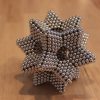Magnets Over the Last 100 Years: From AlNiCo to Neodymium
By eleventh century AD, the ancient Greeks, Romans, and Chinese all recorded their discovery of a seemingly magical rock that attracted iron and other stones: the naturally occurring lodestone. After its discovery, it didn’t take long for the Chinese to develop the first compass between 400 and 200 BC. Thus began the history of the magnet.
The 1930s: Here Comes AlNiCo
Fast forward to July of 1932 –– Japanese magazine Ohm covered a wonderful new magnet that blended nickel, aluminum, and iron. This magnetic material was covered later that same year in the U.S. magazine Iron Age to high praise.
“[The strength of these magnets is]” about nine times that of the usual tungsten magnet steels and two and one-half times that of the best cobalt magnet steels.”
This new magnet was a big deal, especially because of its high temperature and corrosion resistance. The only downside? The magnet was easily demagnetized.
So, why is it known as AlNiCo if the original compound was AINiFe? Although the original magnets were 10% aluminum, 25% nickel, and 65% iron, the iron was soon swapped out for cobalt, and it’s been that way ever since.
The 1950s: Out with AlNiCo and In With Ferrite.
The 1950s marked the end of AlNiCo’s heyday. At the start of the decade, an assistant in the physics laboratory at Philips Industries in the Netherlands accidentally synthesized the materials used in ferrite. When the researchers realized the new material was magnetic, they immediately saw its potential.
With low production costs, high corrosion resistance, and good temperature resistance, ferrite magnets began outselling AlNiCo magnets in the 1960s. The downside? Ferrite magnets are extremely brittle, so they couldn’t (and still can’t) be machined. Machining refers to a controlled material-removal process.
The 1970s: Samarium Cobalt Makes Waves
Though samarium cobalt made a commercial splash in the 1970s, its story began in the late 1960s. In 1966, Dr. Karl Stmat, a civilian researcher at the Wright-Patterson AFB Materials Laboratory, discovered samarium cobalt, the original rare earth magnet.
Its benefits were apparent from the start. Just as ferrite was the obvious choice over AlNiCo, samarium cobalt was the obvious choice over both of its predecessors. They were the strongest magnets yet with similar temperature stability and corrosion resistance.
The downsides? Samarium cobalt was brittle and expensive to produce. As these magnets grew in popularity and became increasingly expensive, they set the stage for what was to come in the 1980s.
The 1980s: Neodymium Takes Over the World
In 1983, General Motors and Sumitomo Special Metals simultaneously and independently developed a new neodymium-iron-boron magnet that changed the game –– again.
Although it was brittle and lacked resistance to both corrosion and high temperatures, neodymium’s incredible strength made it a favorite across multiple applications. In years since, many companies have tinkered with its compositions to increase strength and temperature resistance to give us the material we use today.
Using Rare Earth Magnets
Rare earth magnets are incredibly useful in many of today’s most-used products. Browse through Apex Magnet’s extensive selection, or contact our sales team for assistance in finding the perfect option for you.

